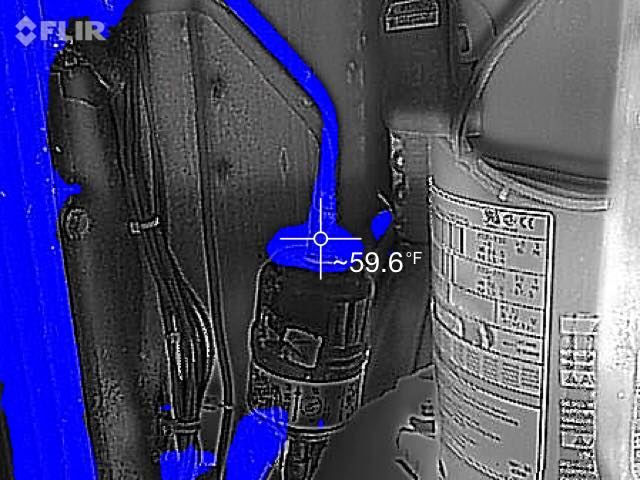Get Tech Tips
Subscribe to free tech tips.
Diagnosing and Finding a Refrigerant Restriction
 Photo by Ulises Palacios
Photo by Ulises Palacios
Refrigerant circuit restrictions can be common things like a plugged filter drier or a restricted metering device. They can also be more difficult to diagnose and stem from exotic issues like a kinked liquid line, blocked evaporator feeder tube, or a compressor connected improperly with a discharge line full of solder (I've seen it).
Symptoms to watch out for
When an undesigned restriction occurs, the refrigerant will “back up” against the restriction, resulting in more refrigerant being present before the restriction and less afterward than designed. Think of it as a refrigerant traffic jam; the refrigerant “road” is congested before the restriction and free and clear afterward. This restriction will result in a pressure drop across the restriction. You'll have higher pressure on the inlet side and lower pressure on the outlet side of the “traffic jam.”
First, we must be aware that a restriction exists in the first place. In the case of the most common liquid line restrictions on HVAC equipment (with no receiver), we will see low suction pressure, high superheat, and normal to high subcooling. (Note: high head pressure isn't typically an indicator of a restriction!)
In those cases, we know that the system is not simply “low on charge” because of the subcooling reading, and we also know it isn't just an evaporator airflow issue because of the high superheat. That leaves us in the realm of restriction. Like anything else, some common sense, a look at the system history, and a visual inspection can find many restrictions without any fancy diagnosis. Still, you sometimes have to put on your thinking cap, grab a pipe or a cigar, and go to work. (Or you can grab your 5 Pillars of Diagnosis cheat sheet.)
Locating restrictions
In a perfect world, we could just connect a gauge anywhere in the system and find the pressure drop. In the real world, we only have two or maybe three points on connection, and they are not sufficient for us to pinpoint a restriction. Luckily, we have temperature drop as a proxy for pressure drop; whenever the pressure drops, there will also be a temperature drop. Unfortunately, by the time the temperature drops enough for us to measure it with a thermometer reliably, it is usually pretty bad, making minor restrictions hard to find. It can also be challenging when the metering device itself is a suspect (and it often is) because the metering device is a DESIGNED RESTRICTION. This means that a pressure drop is its very purpose, but is it restricting too much?
So, to actually FIND a restriction, you are left with a few tools in your arsenal.

Common Sense
Get acquainted with the history of the system. How old is it? What has been done on it recently? Has the refrigerant circuit been open to the atmosphere? If you recently had a burnout compressor, it is very likely that suction and liquid line driers could be restricted. In cases where the system has been running just fine for 7 years, it is more likely that the TXV element tube rubbed out, and now the TXV is slammed down. If the distributor just repaired a leak on it, it is possible that they accidentally filled one of the feeder tubes with solder when they made the repair.
A little common sense can save a lot of random hypotheses. Any experienced technician will agree with the problem-solving principle called Occam's Razor, which states:
With all things being equal, simpler explanations are generally better than more complex ones.
That certainly holds true when looking for restrictions.
Temperature Drop
Grab your most accurate line temperature clamp and start making measurements across possible restrictions, like line filter driers and the liquid line itself. If you find any confirmable temperature drop across a line drier, then you can know it's restricted. Just make sure to double-check. Across a typical liquid line, you will generally only see a few degrees of temperature drop, but it does depend on the ambient temperature, condensing temperature, and line length.
Freeze Test
Sometimes, the exact point of temperature change can be tough to locate. In these cases, when the metering device, distributor, feeder tubes, inlet screen, or evaporator are all suspects, you can do the freeze test. Disconnect the blower and watch the frost patterns. On a properly functioning system, the ice will start right at the outlet of the metering device and extend forward through the feeder tubes and work its way fairly evenly through the coil on the coil piping route. Look for inconsistencies in the pattern, and you can often find a restriction.
If, for example, you see that the frost is starting BEFORE the metering device instead of after, you can bet the restriction is an inlet screen. This test is finicky and requires a trained eye to track the tubing patterns; otherwise, you might think a coil is restricted when it's just the way it's piped. Also, be aware that the designed pressure drop of metering devices containing a distributor and feeder tubes is cumulative across all of those restriction points. That means that in some cases, you may get more frost after the distributor than you do between the metering device and the distributor; this is to be expected.
 Photo by Ulises Palacios
Photo by Ulises Palacios
Thermal Imaging
The holy grail of finding restrictions is the thermal imaging camera. You can see restrictions in real-time and pinpoint the exact location where the temperature change begins. Thermal imaging can even be used to find elusive restrictions, like discharge line restrictions caused by poor brazing practices, condenser feeding issues, or evaporator restriction.
So, the process for finding restrictions is:
- Prove that you have one by looking carefully at your readings
- Use some common sense and perform a visual inspection
- Take lots of temperature measurements until you find it
- Whip out the fancy-pants thermal imaging camera and spot that sucker in no time flat and be the hero with throngs of adoring fans
Keep in mind that it gets even trickier to diagnose when you are working on a system with a receiver. That's because the receiver can usually hold a lot of excess refrigerant, often making a liquid line restriction appear more like a low charge in the readings. Also, minor suction line restrictions, like a kinked suction line, can be very difficult to find because the temperature drop will usually be unmeasurably low.
This is why taking all the system readings in conjunction with some common sense and knowledge of the system's history are your best allies. And, when in doubt, get a thermal imager from TruTech tools.
I told you it wasn't easy.
—Bryan
Here is a great article addressing restrictions in refrigeration systems – Diagnosing A Restricted Liquid Line Can Be Tricky.












Comments
I was train in union school that there shouldn’t be a tempture difference across a liquid line dryer. If you have 2° or more change your dryer. It should be the same temp across the dryer…
I was train in union school that there shouldn’t be a tempture difference across a liquid line dryer. If you have 2° or more change your dryer. It should be the same temp across the dryer…
Other restrictions that may only show up during design conditions could be undersized line set. One situation that comes to mind is manufactured home air conditioning units. One mobile home park crew would never check the manufacturers sizing requirements and would install 3/4 inch suction lines for 3 ton units when the manual called for 7/8ths. Manufactured home units come with precharged condensers, evaporators, and line sets. The line sets are manufactured in assorted sizes however the screw on couplings are all the same size for the suction side. So not properly sizing the line set is easy to do.
.
.
Another scenario where the problem is difficult to diagnose during mild temperature conditions is add-on txvs. A company that I worked for would install add-on txvs and remove the pistons. However there were two times where the add-on kit would have the correct size listed on the box yet the valve was listed as full ton lower. Would not be able to get to the job site during design days and when we did the outdoor temperature would drop to below 80 degrees and everything would check good. Then we were able to get to site when it was around 90 degrees and that was when the problem showed up. Always check the part before installing it. An incorrect part may have been packaged in the box.
Other restrictions that may only show up during design conditions could be undersized line set. One situation that comes to mind is manufactured home air conditioning units. One mobile home park crew would never check the manufacturers sizing requirements and would install 3/4 inch suction lines for 3 ton units when the manual called for 7/8ths. Manufactured home units come with precharged condensers, evaporators, and line sets. The line sets are manufactured in assorted sizes however the screw on couplings are all the same size for the suction side. So not properly sizing the line set is easy to do.
.
.
Another scenario where the problem is difficult to diagnose during mild temperature conditions is add-on txvs. A company that I worked for would install add-on txvs and remove the pistons. However there were two times where the add-on kit would have the correct size listed on the box yet the valve was listed as full ton lower. Would not be able to get to the job site during design days and when we did the outdoor temperature would drop to below 80 degrees and everything would check good. Then we were able to get to site when it was around 90 degrees and that was when the problem showed up. Always check the part before installing it. An incorrect part may have been packaged in the box.
Wow, I didn’t know that thermal imaging can help a lot in AC repair services sometimes. I’d like to get my air conditioner checked soon because it has been making a strange humming noise recently. It’s totally different from the kind of sound it makes when I first got it installed so something might be wrong.
https://www.zimdarsplumbingandheating.com/air-conditioning/
Wow, I didn’t know that thermal imaging can help a lot in AC repair services sometimes. I’d like to get my air conditioner checked soon because it has been making a strange humming noise recently. It’s totally different from the kind of sound it makes when I first got it installed so something might be wrong.
https://www.zimdarsplumbingandheating.com/air-conditioning/
To leave a comment, you need to log in.
Log In